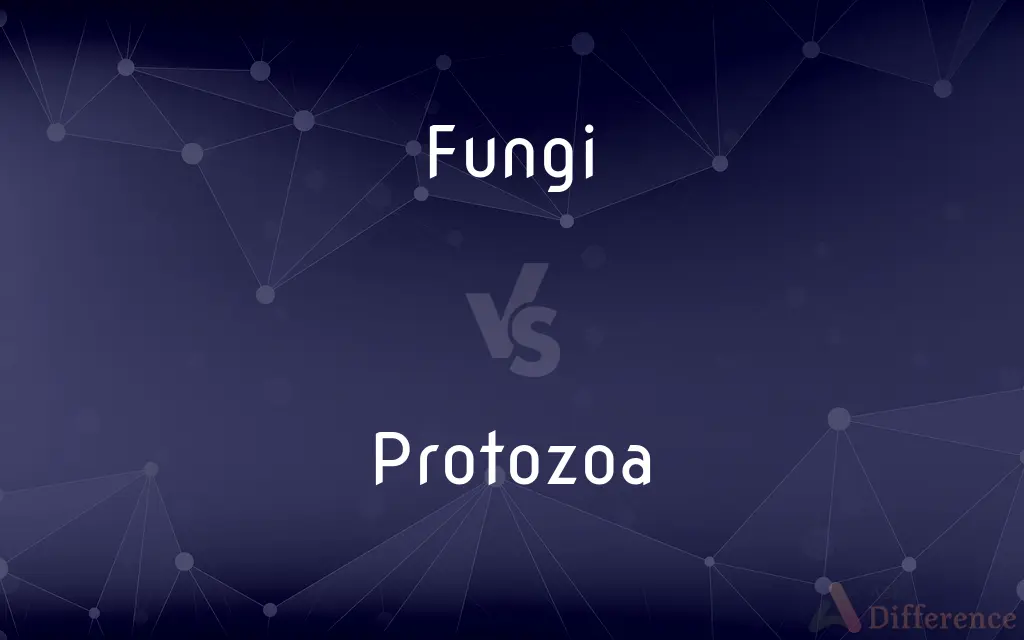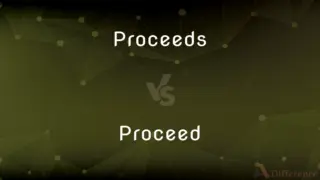Fungi vs. Protozoa — What's the Difference?
By Fiza Rafique & Urooj Arif — Updated on April 17, 2024
Fungi are complex organisms that decompose organic material, whereas protozoa are single-celled eukaryotes, often parasitic or free-living in water.

Difference Between Fungi and Protozoa
Table of Contents
ADVERTISEMENT
Key Differences
Fungi are eukaryotic organisms that include molds, yeasts, and mushrooms, primarily involved in the decomposition of organic substances and nutrient recycling. Protozoa, on the other hand, are single-celled eukaryotes that can be either free-living or parasitic, commonly found in water and soil.
Fungi reproduce through spores, which allow them to spread and colonize new environments efficiently. Protozoa typically reproduce asexually by binary fission but some types also engage in sexual reproduction to increase genetic diversity.
The cell structure of fungi includes a rigid cell wall made of chitin, which provides structural support and shape. Conversely, protozoa do not have a rigid cell wall and are often more flexible in shape, with some being able to change form as they move or feed.
Fungi play a crucial role in ecosystems as decomposers, breaking down dead organic material and releasing nutrients back into the environment. Protozoa are important in aquatic ecosystems, participating in the food web and controlling bacteria populations through predation.
In terms of human interaction, some fungi are beneficial, used in medicine and food production, while others can cause diseases like ringworm or athlete's foot. Protozoa are known for their role in diseases such as malaria, amoebiasis, and sleeping sickness.
ADVERTISEMENT
Comparison Chart
Cellular Organization
Multicellular (mostly)
Unicellular
Reproduction
Sexual and asexual spores
Mainly asexual, some sexual
Cell Wall
Made of chitin
No rigid cell wall
Role in Ecosystem
Decomposers, nutrient recyclers
Predators, food web participants
Impact on Humans
Beneficial and harmful
Mostly harmful (parasites)
Compare with Definitions
Fungi
The vegetative part of a fungus, consisting of a network of fine white filaments.
The mycelium of mushrooms can spread extensively underground.
Protozoa
Protozoa that move using one or more whip-like structures called flagella.
Giardia, a parasite that causes digestive illness, is a flagellate.
Fungi
A reproductive cell capable of developing into a new individual without sexual fusion.
Mushroom spores are spread by the wind to new locations.
Protozoa
Protozoa characterized by the presence of hair-like structures called cilia.
Paramecium, common in freshwater environments, uses cilia to move and feed.
Fungi
Fungi break down and absorb nutrients from organic matter.
Fungi decomposing a fallen log in the forest.
Protozoa
Protozoa that live on or within another organism, deriving nutrients at the host’s expense.
Plasmodium, which causes malaria, is a parasitic protozoan.
Fungi
A unicellular fungus used in fermentation.
Yeast is crucial for brewing beer and baking bread.
Protozoa
A type of protozoa that moves using pseudopodia.
Amoebas are often found in pond water feeding on bacteria.
Fungi
A type of fungus that grows in the form of multicellular filaments called hyphae.
Mold commonly grows on bread and other stored food under moist conditions.
Protozoa
The primary method of reproduction in protozoa, where the cell divides into two genetically identical cells.
Binary fission in amoebas occurs under favorable conditions.
Fungi
A plural of fungus.
Protozoa
Protozoa (also protozoan, plural protozoans) is an informal term for a group of single-celled eukaryotes, either free-living or parasitic, that feed on organic matter such as other microorganisms or organic tissues and debris. Historically, protozoans were regarded as "one-celled animals", because they often possess animal-like behaviours, such as motility and predation, and lack a cell wall, as found in plants and many algae.
Fungi
(pathology) Spongy, abnormal growth, as granulation tissue formed in a wound.
Protozoa
Any of numerous chiefly single-celled eukaryotic organisms, most of which move about freely and ingest food, including the amoebas, ciliates, flagellates, and apicomplexans. Protozoans along with certain algae, oomycetes, and some other groups make up the protists.
Fungi
Alternative spelling of fungee
Protozoa
Plural of protozoan
Fungi
A style of folk and popular music from the Virgin Islands, traditionally performed by bands consisting of banjo, guitar, ukulele, and washboard with various percussion instruments on rhythm.
Protozoa
Plural of protozoon
Fungi
The taxonomic kingdom of lower plants
Protozoa
The lowest of the grand divisions of the animal kingdom.
Fungi
(pun) the one who buys the drinks
Protozoa
In some classifications considered a superphylum or a subkingdom; comprises flagellates; ciliates; sporozoans; amoebas; foraminifers
Common Curiosities
Do fungi and protozoa have a cell wall?
Fungi have a cell wall made of chitin, while protozoa generally do not have a rigid cell wall.
How do fungi and protozoa reproduce?
Fungi reproduce through spores, both sexually and asexually, while protozoa mostly reproduce asexually by binary fission.
What ecological roles do fungi and protozoa play?
Fungi act as decomposers and nutrient recyclers in ecosystems, while protozoa are important in controlling bacteria populations and as part of aquatic food webs.
What are fungi and protozoa?
Fungi are mostly multicellular organisms that decompose organic material, while protozoa are single-celled organisms often found in water.
What are some examples of fungi?
Examples include mushrooms, yeast, and molds.
What are some examples of protozoa?
Examples include amoebas, giardia, and plasmodium.
What is the significance of fungi in food production?
Fungi like yeast are crucial in fermentation processes for making bread, beer, and wine.
How do fungi and protozoa differ in their structure?
Fungi are composed of a network of filaments called mycelium and have a rigid cell wall, whereas protozoa are more flexible in shape and lack a rigid cell wall.
Can fungi and protozoa cause diseases?
Yes, both can cause diseases: fungi can cause infections like athlete's foot, while protozoa can cause diseases like malaria.
Are all fungi harmful to humans?
No, while some fungi cause diseases, others are beneficial and used in medicine and food industries.
What are the key differences in the habitats of fungi and protozoa?
Fungi are found in diverse environments including soil and decaying material, whereas protozoa are predominantly found in moist or aquatic environments.
Are protozoa visible to the naked eye?
Most protozoa are microscopic and require a microscope to be seen, though some can aggregate into visible colonies.
How do protozoa obtain nutrients?
Protozoa ingest bacteria, algae, or other microorganisms, and some absorb nutrients directly from their environment.
What is the role of protozoa in water ecosystems?
Protozoa help maintain bacterial populations and are a key part of the food web in aquatic environments.
Can fungi live in water?
Yes, some fungi are aquatic and play roles in decomposing material in water bodies.
Share Your Discovery

Previous Comparison
Prezygotic vs. Postzygotic
Next Comparison
Proceeds vs. ProceedAuthor Spotlight
Written by
Fiza RafiqueFiza Rafique is a skilled content writer at AskDifference.com, where she meticulously refines and enhances written pieces. Drawing from her vast editorial expertise, Fiza ensures clarity, accuracy, and precision in every article. Passionate about language, she continually seeks to elevate the quality of content for readers worldwide.
Co-written by
Urooj ArifUrooj is a skilled content writer at Ask Difference, known for her exceptional ability to simplify complex topics into engaging and informative content. With a passion for research and a flair for clear, concise writing, she consistently delivers articles that resonate with our diverse audience.















































